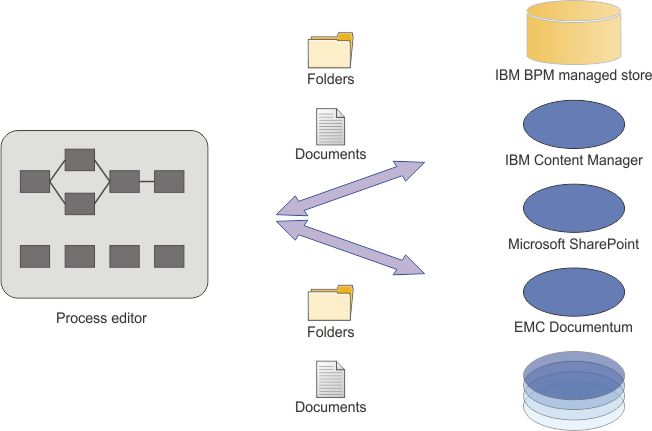Management of folders and documents for ECM systems
When you build a process, the Enterprise Content Management (ECM) folders and documents are managed by IBM® Business Process Manager using the IBM BPM managed store as a repository.
Folders and documents are key concepts in ECM systems. Folders are similar to paper folders. Folders are containers for other folders, called subfolders, or documents. Folders provide a structure for the information on an ECM system. A document might be a credit report document. The credit report document might have a title for the person who is associated with the credit report. The document might have sections for a credit report store and a history of transactions that involve credit for this person. Each time this document was used for a person's credit information, that document structure would be followed. Folders and documents must be managed.
Management of folders and documents with the IBM BPM managed store and an external ECM system
In the Process editor, you can integrate the content of your existing ECM systems with an IBM BPM solution. Your ECM systems are available for integration as you can define the ECM server settings in the process application settings page. See Adding an Enterprise Content Management server.
In the Folders tab of your process, you define the initial folder structure of an instance. The structure consists of references to folders in your ECM systems that are specified by a path. These folder references can be static; for example, references to folders that contain document templates that are relevant to the solution. By using the values of variables, they can also be specific to the instance. A link to a folder specific for a claim instance can be made by including a claimId variable in the path. You can select a Create automatically check box to create this instance-specific folder automatically. See Selecting IBM BPM or an external ECM system to manage folders.
The Content Integration tools provide a way of working with your folder structure at run time. Your users see this folder structure when they work with the instance in IBM Process Portal. See Building a service that integrates with an ECM system or an IBM BPM store.

Migrating process instances between the two ways of managing folders and documents
When you install a new snapshot of a process application, you must decide how to handle the data from the previous snapshot. Specifically, you must decide how to handle instances that are still running from the previous snapshot. An instance is an active process.
When do you migrate instances? Suppose you created a process in a previous release such as IBM BPM 8.5.6, which you created with the Basic Case Management feature that uses the case editor. Next, you created a snapshot of your process application, installed the snapshot on a server, activated it, and started your instances.
Now, you switched your content management mode to IBM BPM. See Changing the way enterprise content is accessed. The IBM BPM mode is based on the IBM BPM managed store, whereas the previous selection is based on the IBM BPM content store. The IBM BPM managed store allows complex folder structures, which means folders can be nested within folders. Once you made this switch, you continued to develop your processes and took another snapshot of your process application. You installed your process application on the server and activated it. Running instances from the previous snapshot can be migrated now to the new snapshot. See Migrating instances. You can migrate an instance that has reached its end state; that is, the instance finished running. However, the content remains unchanged.
- A BPM managed root folder is created in the IBM BPM managed store. The caseFolderId is updated to the new root folder's ID.
- New folders and folder references that are modeled on the new version of the process are added.
- A folder reference that references the previous root folder is created.
- Existing local documents associated with the instance are added to the new root folder. See Local documents.
The reverse situation is not possible. The Basic Case Management feature is no longer in IBM BPM.
You do not have to migrate process instances. You can leave the instances currently running to complete with the previously installed snapshot.